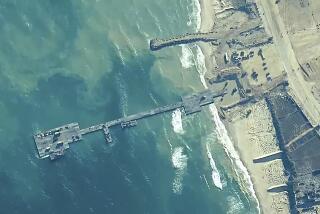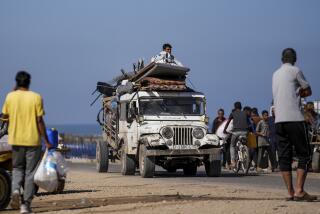Bosnian Factions OK U.S. Airlift : Relief: Representatives of warring sides inspect initial shipments. Mission begins with leaflet drop.
- Share via
FRANKFURT, Germany — On the eve of the planned U.S. airlift of humanitarian aid to eastern Bosnia-Herzegovina, representatives of the region’s warring factions inspected initial shipments at a military hangar near here Saturday, then gave their backing to the mission.
“All the parties expressed interest in cooperating with this operation and gave guarantees that the U.S. Air Force has nothing to worry about,” said Conan E. Peisen, a U.N. official who accompanied the representatives as they inspected two of the 96 pallets waiting to be loaded aboard the relief flights at Rhein-Main Air Base, just outside Frankfurt.
The representatives--two ethnic Serbs, an ethnic Croat and a Bosnian Muslim--had arrived earlier Saturday on a U.S. transport plane from Sarajevo, Bosnia’s capital.
Bosnian Serb leader Radovan Karadzic said his forces would not try to shoot down the American transports, but he suggested that Bosnian Muslim forces might and then blame Serbs in an attempt to draw the United States into the conflict on their side.
French army Gen. Philippe Morillon, commander of U.N. peacekeeping forces in Bosnia, predicted earlier last week that Serbs probably would shoot at the C-130 transport planes, which will be flying unarmed and unescorted into the region. Serbian forces have been blamed for cutting off land routes for aid convoys to the region.
While military spokespersons here refused to comment on when the operation might begin, there were signs the start was imminent.
Late Saturday, two U.S. aircraft dropped about 1 million leaflets over eastern Bosnia, informing residents that food supplies would soon be parachuted to them.
The leaflet drop was expected to precede the start of the actual airlift by one or two days.
Speaking to reporters following Saturday’s inspection, Peisen said he expects the relief flights would continue “as long as they are needed” but stressed that the United Nations hopes to get land convoys through to the stricken region shortly.
He also rejected accusations that the airlift is too dangerous.
“There is risk in any war situation, but in these areas (of eastern Bosnia), the need outweighs the risks involved,” he said.
The airdrops are focused on eastern Bosnian enclaves with a population of about 300,000 people, most of whom have received no outside food or medical supplies this winter.
Reports of starvation from the area coupled with the inability to negotiate the safe passage of land convoys led President Clinton to order the airdrop.
After watching two Serbs pick through a case of military field rations called MREs (meals ready to eat) destined for the region, Mufid Halilovic, who identified himself as an aide to the vice president of the government of Bosnia-Herzegovina, told watching reporters that the help is urgently needed.
“Nothing has come to this region, nothing, no food, nothing,” he said. “We are grateful to the Americans . . . but there should be shame in Europe.”
At a meeting of North Atlantic Treaty Organization foreign ministers in Brussels on Friday, America’s Western European allies said they support the U.S. action but declined to join it, apparently because they viewed it as more symbolic than substantive.
France and Britain both have ground forces in Bosnia operating under U.N. command.
Halilovic distributed photocopies of a document titled “Official Statistics Regarding the Present State in Eastern Bosnia,” which showed the region’s population at 381,000 and listed 3,774 people as having starved or frozen to death. The figure in the column titled “dead children” was 1,675.
The airlift, expected to involve between three and five flights daily, will have the capacity to drop about 60,000 meals per day, officials said.
Airdrops have been used before in Yugoslavia. During World War II, U.S. and British planes airdropped hundreds of tons of food to hungry Yugoslavs.
Meanwhile, in central Bosnia, Serbs fired at about 1,500 Muslim refugees they had forced out of the village of Sipovo, a U.N. official said. The Muslims were bused from their homes and made to trek across battle lines in the dark under Serbian small-arms fire, the official said. U.N. officials said the incident fueled concerns that the Serbs’ practice of “ethnic cleansing” was again under way.
Fighting also intensified in Sarajevo. Mortar shells landed downtown, and three people were killed. Bosnian radio reported clashes across the northern front, with artillery attacks overnight on Gradacac, Brcko and Tesanj, and on the northwestern town of Bihac.
More than 100,000 people have died or been classified as missing since Bosnia’s Muslims and Croats voted last year to leave Yugoslavia. Bosnian Serbs revolted and have captured about 70% of Bosnian territory.
International efforts to forge a peace in the region have faltered; but negotiations are to resume this week at the United Nations.
In Washington on Saturday, Bosnian President Alija Izetbegovic said he hopes the American airdrops will provide an impetus for the talks.
Izetbegovic spoke after meeting with Vice President Al Gore and White House National Security Adviser Anthony Lake for an hour and a half. Clinton was not at the meeting, officials said.
“The involvement of the United States . . . is very important and will give a new impulse” to future negotiations, Izetbegovic said.
Delivering Help to Bosnia
The goal of the airdrop is to channel desperately needed supplies to snowbound villages isolated by military blockades. Planes will fly at 10,000 feet to avoid ground fire.
More to Read
Sign up for Essential California
The most important California stories and recommendations in your inbox every morning.
You may occasionally receive promotional content from the Los Angeles Times.













